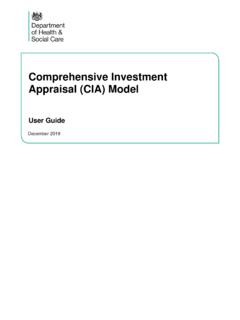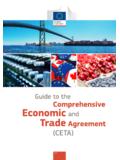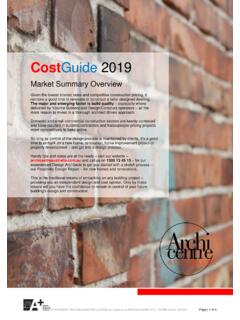Transcription of Basic Economics A Citizen’s guide to the Economy By …
1 1 Basic EconomicsA Citizen s guide to the EconomyByThomas SowellAuthor of the Vision of the Anointed2 Economics is the study of the use of scarce resources, which have alternative a military medical team arrives on a battlefield where soldiers have a variety ofwounds, they are confronted with the classic economic problem of allocating scarceresources, which have alternative uses. Unless their time and medications are allocatedefficiently, some wounded will die inherent reality is that there are not nearly enough beachfront homes to go aroundand prices are just a way of conveying that underlying reality. When people bid for arelatively few homes, these homes become very expensive because of supply anddemand. But it is NOT the prices that cause the scarcity. Even if Congress were todeclare that beachfront homes were a Basic right of all Americans, it still would notchange the realities of the act as a guide for consumers and producers. A free market economic system issometimes called a profit system, when it fact it is a profit and loss system.
2 And thelosses are equally important for the efficiency of the Economy , because they tell themanufacturer what to stop tend to flow to their most valued uses. From the standpoint of society as awhole, the COST of anything is the value that it has as in alternative uses. The real costof building a bridge are the other things that could have been built with that same laborand material. There is also a scarcity of time to consider and the alternative uses of that,as well. The cost of watching a television sitcom or soap opera is the value of the otherthings that could have been done in that same a price-coordinated Economy , any producer who uses ingredients that are morevaluable elsewhere is likely to discover that the costs of those ingredients cannot berepaid from what the consumers are willing to pay for the product. There will be nochoice but to discontinue making that product with those are all kinds of prices. The prices of consumer goods are the most obviousexamples but labor also has prices called wages or salaries, and borrowed money has aprice called changes in response to supply and demand.
3 These changes in price then directresources to where they are most in demand and direct people to where their desires canbe satisfied most fully by the existing sudden and widespread destruction in housing in a given area means that there may notbe nearly enough hotel rooms for displaced people to get the kinds of accommodationsthey would like. If prices remained at their previous levels before the disaster, a family3of four might well rent two room one for parents and one for kids. But when the hotelshot the price up, all four family members will crowd into one room, to save money,leaving the other room for other people who likewise lost their homes and are equally inneed of short, prices force people to share, whether or not they are aware of rise in the first place because the amount demanded exceeds the amountsupplied at existing prices. Prices fall because the amount supplied exceeds theamount demanded at existing prices. The first case is called a shortage and thesecond is called a surplus but both depend on existing is a study of consequences of various ways of allocating scarce resourceswhich have alternative uses.
4 It is not a study of our hopes and scarcity is inherent, shortages are not. Scarcity simply means that there is notenough to satisfy everyone s desires. Right now that scarcity is money based on poorcash flow. With nothing, or very little coming in, every company is looking to stop thebleeding by drastically reducing their spending. This includes wages, inventory, power,and whatever else it takes to survive this. A shortage, however, means that there arepeople willing to pay the price of the good but are unable to find a price coordinated economic system that shares its resources, those who want to usewood to produce furniture, for example, must bid against those who want to use it toproduce houses, paper or baseball bats. Those who want to use milk to produce cheesemust bid against those who want to use it to produce yogurt or ice example, whenever the price of oranges goes up, some people switch to a vacation on the beach becomes too expensive, people may take a cruise instead.
5 Thisis incremental substitution. Not everyone stops eating oranges when they become toopricey. Some continue to eat the same number they always ate. Others cut back, whileothers stop entirely and/or switch to another fruit. In spite of the fact that the orange isstill the same, the value of the orange that each individual attaches to it differs is where we are now. We have some pricey oranges and too many customers areeither switching to another fruit, or just not eating the price of oranges goes up, it means the demand for oranges has exceeded theavailability. But when the price of oranges comes down, it means the supply of orangeshas exceeded the demand for Quick Study of The Rise and Fall of BusinessesA&P was once the largest retail chain in any field, any wherein the world, with salesgreater than the combined sales of leading contemporary retail giants Sears, Penney andMontgomery fact that A&P has shrunk to a fraction of its former size, and is now virtuallyunknown, suggest that industry and commerce are not static things, but dynamicprocesses, in which individual companies and whole industries rise and fall, as a result ofrelentless competition under changing conditions.
6 Half the companies on the Fortune500 list of the biggest businesses in 1980 were on longer on that list a decade the 20s, A&P was making phenomenal rate of profit on its investment neverless than 20% per year. But in the 50s it began to change when they lost $50MM in one52 week period. A few years later it lost $175MM over the same time A&P was prospering up until 1950, it did so by charging LOWER prices thancompeting grocery stores. It could do this because it kept its costs lower and the resultinglower prices attracted vast numbers of customers. When it began to lose customers toother grocery chains, this was because the latter could now sell for lower prices thanA&P. Changing conditions in the surrounding society brought this about together withdifferences in the speed with which different companies spotted the changes and realizedtheir appeared on the scene were shopping malls. As the ownership of automobiles,refrigerators and freezers became more widespread, this completely changed theeconomics of the grocery industry.
7 With a car, shoppers could now buy far moregroceries at one time than they could have carried home in their arms from an urbanneighborhood store before the war. Refrigerators and freezers now made it possible tostock up on perishable items like meat and dairy products. This all added up to fewertrips to the grocery store with larger purchases each grocery stores were experiencing large volume of sales at each given location. Highvolume meant savings in delivery costs from the producer to the supermarket. It alsomeant savings in the cost of selling. It did not take tens time as long to check out onecustomer buying $50 worth of groceries as it did to check out ten customers buying $5worth of groceries each at a neighborhood lingered in the central cities longer and did not follow the shifts of population toCalifornia and other sunbelt areas. After years of being the low price provider, A&Psuddenly found itself being undersold by rivals with even lower costs of doing A&P succeeded in one era and failed in another, what is more important is that theeconomy as a whole succeeded in both eras in getting its groceries at the lowest pricespossible at the time from whichever company happened to have the lowest and Losses An enterprise system is a profit and loss system, and the loss part may be even moreimportant than the profit part.
8 The crucial difference is in what ventures are continued5and which are abandoned. The crucial requirement for maintaining growth and progressis that successful experiments be continued and unsuccessful experiments be terminated. Milton FriedmanKeeping track of the money coming in and the money going out can make the differencebetween profit and loss. It is the hope for profits and the threat of losses that force abusiness owner in a capitalist Economy to produce at the lowest cost and sell what thecustomers are willing to pay for it. In the absence of these pressures, owners in asocialistic environment have far less incentive to be as efficient as possible under givenconditions, much less to keep up with changing conditions and respond to them quickly,as capitalist enterprises must do if they expect to a capitalist Economy , even the most profitable business can lose its market if itdoesn t keep innovating, in order to avoid being overtaken by fact that most goods are available more cheaply in a capitalist Economy implies thatprofit is less costly than inefficiency.
9 Or, Profit is a Price Paid for Efficiency. Thegreater efficiency must outweigh the profit or else socialism in practice would have lowerprices and greater prosperity, which has never is the owner s legal claim to whatever residual is left over after the costs havebeen paid out of the money received from customers. That residual can turn out tobe positive, negative or zero. The ONLY person whose payment is contingent uponhow well the business is doing is the owner of that on Investment & Return on SalesA store that sells pianos undoubtedly makes a higher percentage profit on each sale than asupermarket makes selling bread. But a piano sits in the store for a much longer timewaiting to be sold than a loaf of bread does. Bread would go stale waiting for as long asa piano to be a supermarket chain buys $10, worth of bread, it gets its money back muchfaster than when a piano dealer buys $10, worth of pianos. The piano dealer mustcharge a higher percentage markup on the sale of each piano than a supermarket chargeson each loaf of bread, if the piano maker is to make the same annual percentage rate ofreturn on a $10, investment.
10 When the supermarket gets its money back in ashorter period of time, it can turn right around and re-invest it, buying more bread orother grocery items. In the course of a year, the same money turns over many times in asupermarket, earning a profit each time, so that a penny of profit on a dollar can producea total profit for the year on the initial investment equal to what a piano dealer makescharging a much higher percentage markup on an investment that turns over much a profit of only a few cents on the dollar on sales but with the inventory turningover nearly 30 times a year, A&P s profit rate on investment soared. This low price andhigh volume strategy set a pattern that spread to other grocery chains and to other kinds6of enterprises as well. In a later era, huge supermarkets were able to shave profit marginon sales still thinner, because of even higher volumes, enabling them to displace A&Pfrom industry leadership by charging still lower profits are the difference between what consumers pay and what the products costto produce and distribute, it is important to be very clear about these is no such thing as the cost of producing a given product or service.






